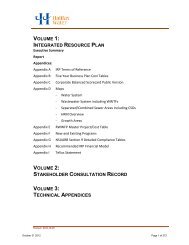Phase I - Halifax Regional Municipality
Phase I - Halifax Regional Municipality
Phase I - Halifax Regional Municipality
Create successful ePaper yourself
Turn your PDF publications into a flip-book with our unique Google optimized e-Paper software.
Colliers International 12 SLR Ref.: 210.05696.00<br />
<strong>Phase</strong> I ESA February 17, 2009<br />
5515 Clyde Street & 1452 Queen Street, <strong>Halifax</strong>, NS<br />
5.8 Ozone-Depleting Substances<br />
Ozone-depleting substances are generally found in equipment such as air conditioners,<br />
refrigerators and freezers. Both pay station buildings on the subject properties house small air<br />
conditioners; other ozone depleting substances are also assumed to be present in the multi-unit<br />
dwelling. Ozone-depleting substances could pose environmental concern for the subject<br />
property.<br />
5.9 Mercury<br />
No mercury-containing instruments or appliances were observed at the time of site<br />
reconnaissance. The buildings on the subject properties should be inspected for any appliance<br />
or instrument containing mercury prior to their demolition. Any mercury encountered must be<br />
properly disposed.<br />
5.10 Radioactive Material<br />
No radioactive materials were observed during the subject property reconnaissance.<br />
5.11 Backfilling Materials<br />
No documentation regarding excavation of the subject property was available for review by<br />
SLR; however, during discussions with site personnel it was discovered that former buildings on<br />
each property were demolished and the debris was buried on-site. If any building debris is<br />
encountered during excavation, it should be tested for regulated materials to determine proper<br />
disposal procedures.<br />
5.12 Radon<br />
“Radon (Rn-222), a radioactive gas associated with an increased incidence of lung cancer, is<br />
formed by the natural radioactive decay of uranium. Geological mapping of rocks and soils with<br />
a potential for high uranium content can be used to interpret regional variations in the<br />
concentration of radon in homes. Because of its effects on human health, radon is considered a<br />
potential "geochemical hazard" where it occurs at high concentrations.” (Geological Survey of<br />
Canada: Environmental geochemistry and geochemical hazards – Radon. R.D. Knight and R.A.<br />
Klassen)<br />
Based on a uranium map of Nova Scotia, it was determined that the subject property is in an<br />
area with moderate uranium content, however uranium mapping alone can not predict<br />
corresponding radon concentration in buildings. No radon testing was completed as part of this<br />
assessment.<br />
SLR
















